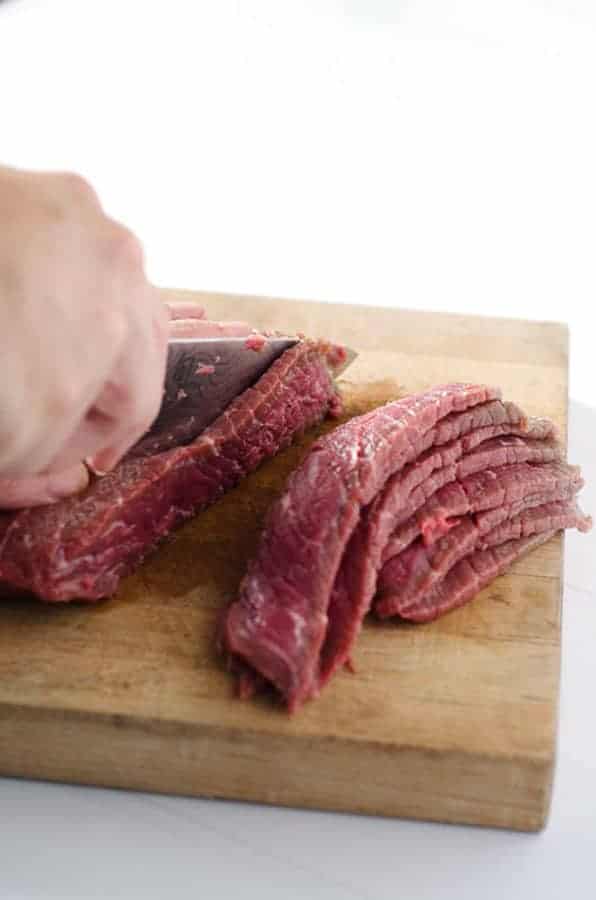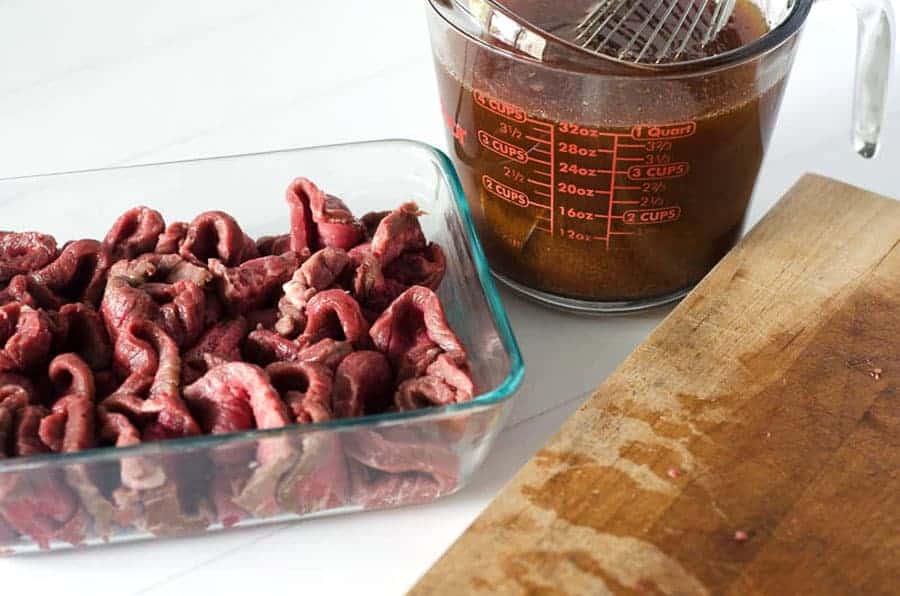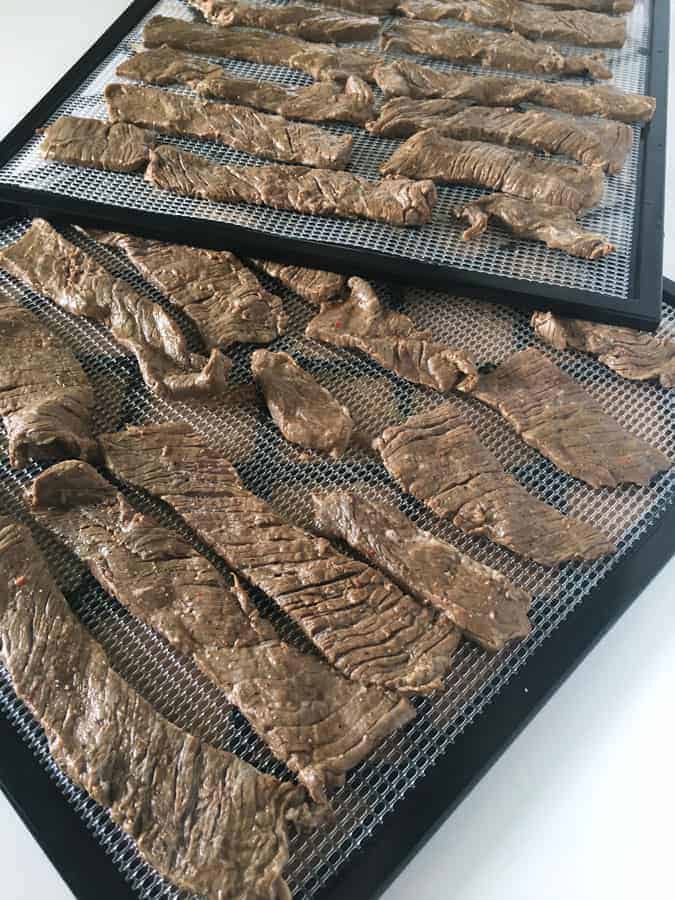This simple paleo beef jerky recipe is delicious, healthy and Whole30 compliant. You'll never eat store bought beef jerky again!
For those of you that know me, you probably also know by now that my husband Brandan loves his "meat projects."
This homemade beef jerky recipe is a recurring meat project in our house, and you'll never hear me complain about it!
In addition to beef jerky, we also spend a lot of time smoking pork belly and curing bacon.
Jump to:
- The best cut of meat for beef jerky
- How to cut meat for beef jerky
- How to make (sugar-free!) paleo beef jerky marinade
- How to marinate beef jerky
- How long to marinate homemade beef jerky
- How to dehydrate beef jerky
- How long does it take to make beef jerky in a dehydrator?
- Can you make beef jerky in the oven?
- Can you cure jerky for too long?
- How long does homemade beef jerky last?
- Recipe notes
- Recipe
The best cut of meat for beef jerky
We've made this simple beef jerky recipe out of various cuts of meat over the years, but london broil comes out the best.
It's all in how you cut it, but if you do it right, it comes out thick enough to hold up to dehydration, but not so thick that you feel like you're chewing on the bottom of a shoe when you eat it.

How to cut meat for beef jerky
So, the cutting. Here's the deal:
1. Press down on the piece of meat with one hand. Put pressure on it; just holding it is not enough. This is essential to the beef jerky science!
2. Using a very sharp knife, cut the london broil into as thin of strips as you can manage. We use this 6" Shun chef's knife. (Yes, that knife is expensive. Yes, it is worth it. We got it when we got married 9 years ago and it's still the best one we've got.)
3. Press your meat. When you pick up your hand, are there indentations from you pressing down on it? If not, press harder.



Now we've got our meat strips, but we've got to make our marinade.
How to make (sugar-free!) paleo beef jerky marinade
In a large measuring cup (that's a 4-cup Pyrex in that photo) or mixing bowl, whisk together all your ingredients except the meat.
(Can you whisk meat? Weird. I don't even know if that's a thing.)
We keep the marinade paleo by using pineapple juice as the sweetener and coconut aminos in place of soy sauce. Winning!
Now, we want to marinate our meat, but if we lay it all in one flat layer, the marinade won't get in between the slices or in the cracks and crevices. So, we have to arrange our beef jerky meat appropriately to maximize surface area exposure. (I told you this was science!)
How to marinate beef jerky

Start arranging your jerky slices in a flat pan or dish. You want to kind of twist and make circles and stand them on their sides in a single layer as best as you can - this is going to get the maximum surface area exposure to the marinade!
When you're done, it should look something like this:

Whisk your marinade one more time just to make sure it's all well incorporated, then pour the whole mixture over the meat into the pan or dish.

How long to marinate homemade beef jerky
You want to marinate it long enough that the meat absorbs the flavors of the marinade.
We recommend about 48 hours, but you could do as little as 24 hours and as long as 72 hours and still get great and flavorful results.
How to dehydrate beef jerky
We use the Excalibur 5 Tray Dehydrator. It is hands-down the best dehydrator ever. We've tried a few different ones over the years, and the Excalibur brand is the bomb. (If you don't have one, that's ok! Scroll down -I'll show you how to do it in a regular oven too.)
If you do a lot of dehydrating, or are looking to start, I highly recommend getting one of these. Once we purchased it, we started making a lot more things in the dehydrator.
You can use it for this simple beef jerky recipe, but also dehydrating various fruits and veggies for healthy on-the-go snacks!
To dehydrate your beef jerky, you'll want to lay them out in a single layer on the trays.

How long does it take to make beef jerky in a dehydrator?
Insert the trays into the dehydrator and set to the jerky setting at 150°F. We cook ours for about 8 hours, but there's more science involved here too - you have to watch the consistency of the meat, because dehydration depends on ambient temperature and humidity.
I'd recommend checking it around the 5-6 hour mark periodically, stopping when it gets to the right consistency and moisture level you prefer.
Can you make beef jerky in the oven?
Yes! Follow all the steps above. Then when putting in the oven, make sure you have it on an oven-safe baking rack like this one with a baking tray underneath to catch any drips.
Set your oven to the lowest setting possible. This is likely the "keep warm" setting - our "keep warm" is 170°F. You can go as high as 200°F and still be ok- you'll just cook for slightly less time.
Can you cure jerky for too long?
Absolutely. If you over-dehydrate your beef jerky, you'll end up with meat that is very tough to chew. You want it to maintain a little bit of tenderness, but get dry enough that it can be stored at room temperature without any issues.
How long does homemade beef jerky last?
In our house, not very long!
You can keep this paleo beef jerky at room temperature in a sealed container for about a week. We like to fold up a paper towel and place it in there with the jerky to absorb any excess moisture.
You can also store it in the fridge for up to two weeks.
Recipe notes
This paleo beef jerky recipe contains no added sugar and no soy. It is the answer to your Whole30 snacks!
You don't need a dehydrator to make this, but it does make it easier. You can also make it in the oven.
London broil makes the best jerky meat.
You can marinate anywhere from 24 to 96 hours.
Depending on the temperature and humidity in your home, drying times may vary. Be sure to check your beef jerky periodically during dehydration.
Recipe

Simple Homemade Beef Jerky
An easy homemade beef jerky recipe that is both delicious and Whole30 compliant. You'll never eat store-bought jerky again!
Ingredients
- 3 lb london broil
- 2 cups pineapple juice
- 1 cup apple cider vinegar
- 6 oz coconut aminos
- 2 oz lemon juice
- 1 teaspoon paprika
- 2 Tablespoons smoked salt
- 1 teaspoon black pepper
- 1 teaspoon ground ginger
- 1 teaspoon onion powder
- 1 teaspoon garlic powder
- 1 teaspoon chili powder
Instructions
- Using one hand to press down on the meat, thinly slice the london broil into strips, cutting across the grain of the meat.
- In a bowl, whisk together all other ingredients until well incorporated.
- Arrange the strips of london broil with "meat space," allowing for maximum exposure to the marinade.
- Pour the marinade over the meat, then cover and place in the refrigerator for anywhere from 1-3 days (at least 24 hours is recommended).
- When ready to dehydrate, remove the meat from the marinade and place in a single layer on dehydrator sheets or on a baking rack on top of a baking sheet in the oven.
- Dehydrator: Place trays in the dehydrator and set to the jerky setting, or to 150°. Dehydrate for up to 8 hours. (See notes for additional details.)
- Oven: Place baking sheets with racks in an oven preheated to between 175-200° for up to 6 hours. (See notes for additional details.)
Notes
- When deciding how long to dehydrate, you have to watch the consistency of the meat. Dehydration depends on the ambient temperature and the humidity, so dehydration times may vary. After the first few hours, you'll want to check on it periodically to make sure it's at the consistency you want!
- I recommend this Excalibur dehydrator. It is the best!
Recommended Products
As an Amazon Associate and member of other affiliate programs, I earn from qualifying purchases, at no additional cost to you. Thank you for your support!
Nutrition Information:
Yield: 12 Serving Size: 12 servingsAmount Per Serving: Calories: 378Total Fat: 22gSaturated Fat: 8gTrans Fat: 0gUnsaturated Fat: 10gCholesterol: 132mgSodium: 1457mgCarbohydrates: 9gFiber: 0gSugar: 7gProtein: 34g
If you’ve tried this paleo beef jerky recipe or any other of my recipes on the blog, I want to see! Tag me on social media and follow along for more delicious recipes. You can find me on Facebook, Instagram and Pinterest to see more delicious food and what I’m getting into.
I may earn a small commission off purchases made through affiliate links in this post from Amazon and other sellers. This helps me continue to run the blog and keep providing you fresh content. Thank you for your support!






Kara
This was great and definitely did not go to waste! The pineapple flavor was really good but maybe a little too much/too overpowering. I think it needs something to compliment it a bit, peppers or something like someone said.
Ginnie Levine
We made this recipe and really enjoyed it. But can you please explain the nutritional information for this recipe? How large is a serving? I’m just trying to understand the numbers—ex. Calories: 378 calories, Sodium: 1457 mg.
Thank you in advance.
Jessica
Hi Ginnie - thanks for reaching out, and I'm glad you enjoyed the recipe! The nutritional information on this one is difficult. The calculator is automated and is simply taking into account everything in the recipe. Since we're just curing it in the salt and juices, you're not actually consuming those. It's seeing the amount of salt in there and calculating that per serving. I have it set to 12 servings for a 3# london broil. In this case, the nutrition calculator won't give you the correct numbers for what you're actually consuming, unfortunately. I recommend just enjoying a piece or two and not worrying too much about it, if that's possible for you!
Derek
I made this and it's really tasty. It's a big hit with the rest of the family, too. I think I'll experiment with some red pepper flakes next time around! Seems like it could complement the pineapple flavor.
Jessica
So glad you liked it Derek! Let me know how the RPF addition turns out.
Jon
@Derek,
April Weseloh
Excited to try this! Could I use smoked paprika and regular salt?
Jessica
Hi April! Yes, you can definitely use smoked paprika and regular salt. I hope you enjoy!